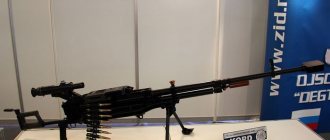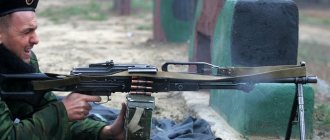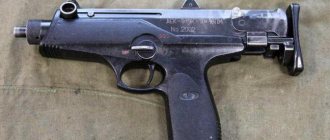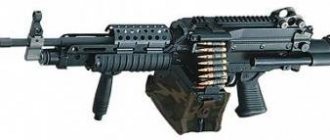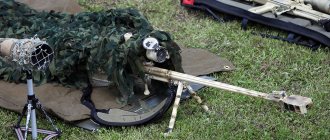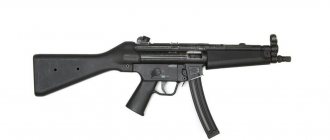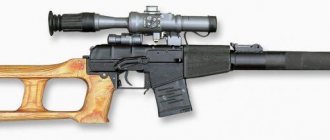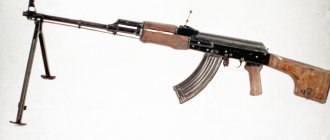The role of multi-caliber machine guns in the modern realities of armed conflicts is increasing, which in almost every way determines their creation in almost all leading countries, including Russia. With all this, an analysis of the features of Russian heavy machine guns in comparison with other more well-known and widespread foreign analogues shows that in their weight and size features, reliability of operation and rate of fire, Russian-made machine guns are superior to foreign ones. First, this concerns the new Kord multi-caliber machine gun.
The Kord multi-caliber machine gun is designed to eliminate enemy personnel, combat fire weapons and lightly armored targets at a range of up to 2000 m, and also hit targets in the air at oblique distances up to 1500 m. The Kord machine gun has a caliber of 12.7, it shows beautiful technical properties. The main purpose of its creation was the need to replace Utes machine guns in the troops.
custom_block(1, 68775763, 1595);
Creation Story
The main reasons for replacing the NSV 12.7 Utes machine gun after almost 20 years of its introduction with the Kord machine gun were:
- certain shortcomings of the cliff were identified, namely, the demonstrated accuracy of fire did not meet modern requirements;
- After the collapse of the USSR, the creation of NSV machine guns remained on the ground in Kazakhstan and Ukraine.
Work on modernizing the Utes machine gun in the 1990s began at the SKB plant named after. Degtyarev in the city of Kovrov. These are gunsmiths Yu.M. Bogdanov, V.I. Zhirokhin, N.M. Obidin, A.A. Namitulin.
When developing a new weapon, gunsmith designers can successfully solve 3 most important problems right away:
- to increase the stability of the machine gun and reduce the recoil energy, which made it possible to create an infantry version of the Kord machine gun, mounted on a bipod;
- ensure the process of independence of the actions of automation and barrel devices, which has a beneficial effect on the properties of shooting accuracy and eliminates resonant vibrations of the machine gun;
- significantly increase the survivability of the machine gun barrel, so a multi-caliber machine gun could be equipped with only one barrel.
The new machine gun received the name “Kord”, as well as a modernized locking system, a new barrel with a muzzle brake-flame arrester.
custom_block(1, 74769240, 1595);
Purposeful work on the creation of a new machine gun was completed in 1997, and subsequently in 1998 the Russian multi-caliber machine gun "Kord" was adopted into service in the main 3 variants:
- tank - 6P49;
- infantry - 6P50;
- with left-hand power supply - 6P51.
The basic option was the Kord tank, equipped with an electric trigger. It is installed on the turret of the T-90 tank. The infantry version is intended for installation on machine guns, as well as installations of machine gun systems. The left-hand-fed version is used for joint use with right-handed machine guns - in twin sea- and ground-based installations.
Russian large-caliber 12.7-mm machine gun "Kord"
In modern realities, the role of large-caliber (heavy) machine guns in armed conflicts is increasing, which determines their development and production in Russia, the USA, Great Britain, Belgium and other countries of the world. At the same time, an analysis of the technical characteristics of Russian heavy machine guns in comparison with the widespread and most well-known foreign analogues shows that Russian machine guns are superior to foreign ones in terms of rate of fire, their weight and size characteristics and the reliability of automatic operation. First of all, we are talking about the newest large-caliber machine gun “Kord”. The large-caliber 12.7-mm machine gun “Kord” (“designed by Degtyarev gunsmiths”) was developed by specialists from the Kovrov arms plant named after Degtyarev (ZID) in the 1990s. This machine gun was intended to replace the 12.7 mm NSV and NSVT “Utes” machine guns in the army. The main reason for the replacement was the division of the country. The production of NSV heavy machine guns is currently located on the territory of Ukraine. In addition, when creating their own Russian heavy machine gun, Russian gunsmith designers were faced with the task of increasing shooting accuracy.
The gunsmiths of the ZID plant were able to quickly create a 12.7-mm machine gun, which was developed taking into account all modern realities and was eventually adopted by the Russian army as part of a number of unified models under the designation “Kord”. The Kord machine gun is an automatic weapon with a belt feed (cartridges can be fed from both the right and left sides). The machine gun barrel is air-cooled and quick-changeable; it ensures uniform heating of the barrel when firing, and hence its uniform thermal expansion (deformation). Thanks to this, it was possible to increase the shooting accuracy compared to the Utes heavy machine gun by 1.5-2 times. The Kord machine gun is designed to destroy fire weapons and lightly armored targets, as well as enemy infantry at a range of up to 1.5-2 kilometers, as well as combat air targets at inclined ranges of up to 1.5 kilometers.
The design of the Kord machine gun is based on gas-operated automatics. The barrel is locked using a wedge gate. The trigger mechanism has a safety device against accidental shots and can be controlled either manually (from the trigger mounted on the machine) or by electric trigger (in the tank version of the machine gun).
It is worth noting that the Kord heavy machine gun is the first in the world that allows firing from a bipod, and, if necessary, even from the shooter’s hands. Today it is the lightest among all full-fledged 12.7 mm machine guns. For example, an American Browning M2 Heavy Barrel machine gun of the same caliber, mounted on a tripod, weighs 58 kg, while even the body of the American machine gun itself weighs 38 kg, which is almost 20% more than the weight of the Russian Kord machine gun on a bipod. Another American machine gun, the XM312, although it weighs less than the Kord, cannot be considered its full-fledged analogue due to its very low rate of fire - only 260 rounds/min (207.84 g/sec versus 520 g/sec for the " Korda"). The weight characteristics of the modern Russian 12.7 mm machine gun make it possible to raise the question of replacing the Kalashnikov machine gun in a platoon level, especially taking into account the fact that another domestic machine gun, the 7.62 mm Pecheneg, weighs only 8.2 kg on a bipod , which allows you to equip a rifle squad with it instead of the RPK-74 or RPK.
At the same time, the new heavy machine gun is able to conduct effective fire from both prepared and unprepared fire, as well as moving and stationary vehicles, from buildings and structures in any position of the fighter. At the same time, the relatively small weight of the entire complex, as well as the available ability to quickly transfer the machine gun from traveling to firing position, allows the crew to quite easily change their firing position. Which, in turn, increases the survivability of the crew, as well as the effectiveness and surprise of the impact on the enemy. An important and quite attractive feature of the Korda for the Russian Armed Forces is the similarity of its docking and weight and size characteristics with the Utes machine gun, which allows the latter to be replaced in all existing systems without any additional technical work.
When creating a new machine gun, gunsmith designers from Kovrov managed to successfully solve 3 important design problems: - they were able to reduce recoil energy and increase the stability of the machine gun, which made it possible to create an infantry version of the Kord machine gun, which is mounted on a bipod; — to ensure the process of independence of the actions of the barrel mechanisms and automation, which eliminates resonant vibrations of the weapon and has a positive effect on shooting accuracy; — significantly increase the survivability of the machine gun barrel, which for the first time made it possible to equip an automatic weapon of such a large caliber with one barrel.
Targeted work on the development of a new machine gun was completed in 1997; in 1998 it was already put into service in 3 main versions: 6P49 (tank), 6P50 (infantry) and 6P51 (with left-hand feed). The basic one is the Kord tank machine gun, which is equipped with an electric trigger. The infantry version of the machine gun is intended for installation in installations of machine gun systems and on machine tools and is intended for effective fire support of infantry units in battle. The left-hand-fed version of the machine gun is used for joint use with right-handed machine guns - as part of twin land- and sea-based installations.
An analysis by experts of the use of large-caliber machine guns in modern combat has demonstrated that when used in infantry combat formations, the weight of a machine gun cannot exceed 40 kg. In addition, the need was identified to create a single large-caliber 12.7-mm machine gun, which would be used both on armored vehicles, cars and helicopters, and after removal from them could be used directly in infantry combat formations. At the same time, all existing infantry weapon systems of this caliber had a number of significant shortcomings that made such use difficult. The main one, naturally, was the significant weight, which limited the mobility of soldiers, as well as the insufficient stability of the precision characteristics of the weapon.
It was to eliminate all of the listed shortcomings and expand the capabilities of combat use that the “Kord” was created and is being promoted as a single unified large-caliber 12.7-mm machine gun on a machine gun on a bipod (6P50-1), which can be mounted on military equipment and a variety of machines, and also be used as a manual one.
To fire from the Kord machine gun, 12.7 mm cartridges with BZT-44 and B-32 bullets are used. The machine gun fires in short (2-3 shots) and long bursts (10-15 shots), and continuous firing mode can also be used. The machine gun is fed from a portable magazine that can hold 50 rounds. It is allowed to fire with the machine gun belt placed on the side of the machine. The design of the machine gun and machine gun provides a wide sector of fire both vertically and horizontally while maintaining high accuracy and accuracy of fire. For aiming, the machine gun is equipped with an open-type mechanical sight; various options for optical sights and night vision sights can also be installed on it.
The very high level of technical solutions implemented in the machine gun provided the Korda with universal operational and combat qualities. The Russian machine gun differs from its direct analogues in: - trouble-free operation and the ability to conduct fairly intense fire without additional cooling of the machine gun barrel while maintaining aiming accuracy; — high level of reliability at ambient temperatures from –50 to +50 degrees Celsius, after immersion in water, in dusty conditions, without multi-day lubrication and cleaning, during icing and in other extreme operating conditions; - stability of the rate of fire and combat accuracy, accuracy within the entire technical service life; - ease of maintenance.
Complete with a rack and a machine gun mount, the Kord with bipod can be mounted on any armored or automotive vehicles, boats, railway platforms, sea vessels, helicopters. If a machine gun is placed on site, its design allows you to mount the cartridge box on the swinging part of the installation, collect belt links, spent cartridges or reflect them (down-to-right or forward), fix the machine gun in the “stowed” mode, and quickly move the machine gun relative to the installation for placement inside the carrier from the door, hatch and so on.
Today, a version of the Kord machine gun has also been created, which can use the widely used NATO-type 12.7x99 mm ammunition (Russian 12.7x108 mm cartridge). Today, 22 countries are involved in the production of these cartridges. The operational and technical characteristics of this version of the machine gun are similar to the basic version, with structural differences in the feed mechanism and barrel.
In modern realities, a single large-caliber machine gun "Kord", used in conjunction with a 30-mm automatic grenade launcher AGS-30, as well as a new 12.7-mm sniper rifle, ATGM "Kornet-E" and MANPADS "Igla-S", fits perfectly into the concept of armament of mobile units of special forces.
Performance characteristics:
Caliber - 12.7 mm (cartridge 12.7x108 mm). The target firing range is up to 2000 m. The firing rate is at least 600 rounds/min. The initial speed of the bullet is 829-860 m/s. Horizontal aiming angles on the bipod are ±15 degrees. The weight of the machine gun without the machine is 25 kg, with the machine - 32 kg. Barrel weight - 9.25 kg. The weight of the belt with 50 rounds is 7.7 kg, the weight of the loaded magazine is 11.1 kg. The technical life of the barrel is at least 10,000 rounds. Maximum armor penetration at a distance of 100 meters is up to 20 mm.
Sources of information: https://otvaga2004.ru/kaleydoskop/kaleydoskop-inf/pulemet-kord https://www.zid.ru/products/defence/44/detail/176 https://army-news.ru/2011 /08/krupnokalibernyj-pulemyot-kord https://worldweapon.ru/strelok/kord.php
Tactical and technical properties
The Kord machine gun shows the following performance characteristics:
- Caliber - 12.7 mm.
- The rate of fire is 600 rounds per minute.
- The initial bullet speed is 820 - 860 m/s.
- Target firing range – 2000 m.
- Barrel weight - 9.25 kg.
- The body weight of the machine gun is 25.5 kg.
- The weight of the loaded magazine is 11.1 kg.
- The weight of the belt with 50 cartridges is 7.7 kg.
- The horizontal aiming angle of the gun on the bipod is ± 15 degrees.
- The accuracy of combat at a distance of 100 m is <300 mm.
- Technical resource - 10,000 shots.
- Armor penetration at 100 meters - up to 20 mm.
Main technical characteristics of the SVN rifle
Although already in the 80-90s the majority of sniper rifles were automatic, the creators of the large-caliber SVN rifle, focusing on the fact that many snipers of special units use classic “bolt guns” for high-precision shooting, that is, rifles that are reloaded manually, the SVN sniper rifle also received manual reloading system. That is why fire can only be fired in single shots. Despite the seeming archaic nature of such a design, many hunters know that the best accuracy is produced by old rifles that do not use the principle of automation in their work.
Since the length of the barrel of a sniper rifle determines its range, most large-caliber rifles have impressive dimensions and are very inconvenient to use. To rid their creation of this shortcoming, the creators of the SVN used the “Bullpup” scheme. This not only made it possible to increase the barrel length while maintaining the overall dimensions of the rifle, but also significantly lightened the rifle. The weight of the SVN was significantly lower than that of domestic and even foreign analogues.
After a number of modifications, the new rifle was named KSVK or Kovrov large-caliber sniper rifle. After the weapon was put into service, which took place only 15 years later, the rifle was called ASVK or large-caliber army sniper rifle.
Ammunition
custom_block(5, 25832436, 1595);
The ammunition includes 12.7 mm cartridges:
1. with armor-piercing incendiary bullets;
2. with incendiary tracer bullets.
ZiD states that the main ammunition is B-32 and BZT-44. With all this, the Kord multi-caliber machine gun can also use the following cartridges:
- incendiary instant action MDZ;
- armor-piercing incendiary BS-41, which has a bullet with a special tungsten core, it significantly increases armor penetration.
A B-32 bullet can penetrate 20 mm steel from 100 m, while a bullet from BS-41 cartridges will do the same from a distance of 750 m. An iron link is used to equip the belt.
How the rifle works
The ASVK large-caliber sniper rifle operates on the following principle:
- Reloading of weapons occurs only in manual mode. In order to fire a shot, you need to pull the trigger. After each shot, the rifle must be reloaded;
- The process of feeding cartridges occurs through the use of a 5-round magazine;
- The cartridge feeding mechanism has a rigid connection to the rifle’s reloading handle and has a slider-type design;
- During the manual reloading process, cartridges are fed into the receiving window due to the operation of a pusher, which operates thanks to two flat magazine springs;
- In order to lock the bolt of the weapon, you need to turn the reloading handle down in the extreme forward position of the bolt. To unlock it, just lift it up.
All other operations, including removing spent cartridges, cocking the mainspring and unlocking the barrel, occur through the use of a manual reloading mechanism.
Design features
- The type of fire is produced in bursts. Single firing is carried out by abruptly pressing the trigger lever.
- The sight is open type, mechanical, at 2000 m. It is possible to install night and optical sights. For this purpose, the light machine gun was equipped with a bracket for mounting night and optical sights.
- Right-handed or left-handed belt feed (left-handed design is used in coaxial machine gun mounts).
- The machine gun is built on the basis of gas-operated automatics. The barrel is closed with a wedge bolt. The trigger mechanism has a built-in safety device against accidental shots. It can be controlled manually (easel version - from the trigger), or from an electric trigger (if the tank version).
- The air-cooled, quick-change barrel is created using ZID technology, which ensures uniform heating during firing, and, accordingly, uniform thermal expansion of the barrel. As a result, the shooting accuracy is increased by 1.5-2 times compared to the NSV, and the possible radial deviation at a distance of 100 m is only 0.22 m.
In modern realities, the Kord multi-caliber machine gun, used in conjunction with the 30-mm AGS-30 grenade launcher, including the 12.7-mm sniper rifle, Igla-S MANPADS and Kornet-E ATGMs, impeccably fits into the concept mobile units of special forces.
Description
Automatic option, feeding is carried out on both sides, which is very useful. Based on the principle of construction, it is similar to a gas-operated machine; the piston itself is located under the barrel, which is equipped with cooling and can be quickly replaced. The trigger mechanism is also mechanical, depending on the installation. A fuse is also included to prevent accidental flights. The sight is adjustable, you can install additional ones, night and optical. Thanks to uniform thermal heating and expansion, the accuracy is increased by 2 times compared to NSV. Externally, it has undergone virtually no changes; an inexperienced eye will not be able to distinguish them.
The manufacturer claims that the new ones are good for up to 10,000 shots, while the old ones could only withstand 4,000.
The cartridge case is ejected forward. The Kord light machine gun is also no different from its predecessor in assembly and disassembly.
Sniper complex 6S8 "Kord"
In 2013, the Ministry of Defense, after Municipal tests, adopted the 12.7 mm 6S8 Kord sniper system. The sniper complex is designed for:
- destruction of unarmored and lightly armored vehicles at distances up to 1000 m;
- damage to manpower in armored protection equipment at distances of up to 1500 m;
- combating snipers armed with rifles of 9 or 7.62 mm caliber;
- to combat single and group targets.
The complex includes a 7N34 sniper cartridge, a 12.7-mm ASVK (6B7P) sniper rifle, and a night or optical sight.
The sniper complex was created on the basis of the results of the creation of the Kord machine gun, as well as the study of combat experience acquired during anti-terrorist and combat operations.
Distribution and exploitation
So far, CORD has not received significant distribution. This is also explained by the fact that the production of the Utes machine gun was preserved in the countries that produced the T-72 tank under license, including Serbia and Poland. Moreover, both of them managed to begin serial production of NSV chambered for the NATO cartridge 12.7x99mm. An export version of the KORD chambered for this cartridge was in development, but there is no information about its mass production.
In 2013, Finland became interested in the weapon – they were considering the possibility of replacing the NSV in service with it.
KORDs were supplied to Syria, to government troops. There was information about the presence of Kovrov machine guns in Mali and Namibia. But rumors that KORDs are in service with the Donbass republics turned out to be disinformation. The notorious external similarity of the new weapon with the “Cliff” had an effect.
Mass-sized mock-ups of the machine gun were not available for sale.
Modifications of the Kord machine gun
6P49 - tank version with electric trigger. This is the basic version of the introduction of a machine gun.
6P50 - infantry version of the machine gun. Used to support motorized rifle units on mounted machine gun systems.
6P50-1 - infantry version mounted on the 6T19 machine gun. Includes pistol grip, stock, bipod.
6P50-2 – machine gun mount weighing 52 kg. It is used for arming mobile or stationary military equipment.
6P50-3 – machine gun mount weighing 75 kg. Height is adjustable. A machine gun with a 6U16 mount is mounted on an SP rack, which is height-adjustable to suit the shooter’s proper position.
6P51 – left-handed “Kord” machine gun weighing 27 kg. It is used in coaxial machine gun mounts of various locations (ground, sea).
Features of the ASVK sniper rifle
The large-caliber sniper rifle, made according to the “Bullpup” scheme, received a heavy barrel made by cold forging. This barrel is “floating”, since it is fixed in a cantilever. The rifle's muzzle brake, which significantly reduces recoil, also combines the function of a flash suppressor. The bolt action design allows the rifle to be reloaded without taking your eyes off the target. The entire design of the new sniper rifle is such that all its elements reduce recoil as much as possible and increase the accuracy of combat. Although the appearance of the ASVK is quite unusual, the heavy barrel, rigid receiver and manual reloading make this weapon one of the world's best examples of large-caliber sniper rifles.
To make the process of reloading a rifle as easy as possible during combat operations, the designers placed the charging handle and the safety box on the right. The fuse box simultaneously acts as a lock for the receiver window cover. The cartridges are supplied from the magazine, which is located between the pistol grip of the weapon and its butt. The magazine itself holds 5 rounds.
There is a window on the right side of the receiver that serves to eject spent cartridges. If the rifle is not in use or is not in a state of combat readiness, this window should be closed with a special cover. This is done to prevent various foreign objects from getting into the rifle’s mechanisms, which could cause problems during subsequent shooting.
The ASVK is equipped with special bipods, which are designed for more convenient targeted fire. The bipod is attached to the receiver using a special rod. When transporting a sniper rifle, the bipod easily folds forward, facilitating the process of transporting the weapon. The rifle has a special handle for moving the weapon over significant distances. It is located strictly at the center of gravity of the rifle.
A large-caliber sniper rifle can be fired using both open sights and various types of sights. As standard, the sniper rifle is equipped with an optical sight. If this is a modification for the dark, then the sight will be a night sight. The main sights for ASVK are:
- Optical sight 1P71 (day optics);
- 1PN111 (night sight).
In addition, the following sights can be installed on weapons:
- PSO-1;
- POS-12x50;
- POS-13x60.
It should be remembered that although open sights are very rarely used when shooting from sniper rifles, their presence is necessary. Since if the optical sight is damaged, the sniper will be practically unarmed.
